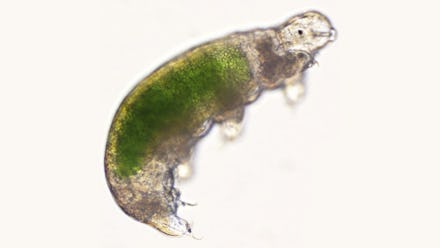This Amazing Creature Was Just Brought Back to Life After Being Frozen for 30 Years

No, this microscopic creature didn't discover the fountain of youth — it's just incredibly strong. In 1983, Japanese scientists accidentally scooped up two tardigrades and an egg when they were collecting a sample of moss. Tardigrades, also known as water bears, are extremophiles, which means they can thrive in extreme temperature and pressure conditions.
One tardigrade and the egg lived up to their name when they survived being frozen for the last 30 years and six months. According to Gizmodo, scientists stored the organisms at minus 4 degrees Fahrenheit, or minus 20 degrees Celsius, and started the thawing process in March 2014.
Slowly but surely, two of the three specimens have been doing the extremophile version of yawning and stretching back to life. Scientists have been tracking their progress, which is recorded on ScienceDirect's website — it reads like observations of an adult human trying to get out of bed on a Monday morning.
On the first day after rehydration, the surviving tardigrade, affectionately called SB-1, was observed "moving the fourth legs," and by the sixth day it was "struggling to lift itself."
It was two weeks before the organism began to fully return to its normal functions — moving and eating — but still scientists are marveling at the findings for a number of reasons. Gizmodo reported that prior to this study, the longest a tardigrade has been able to withstand freezing was nine years, which means these tardigrades set a new world record by 11 years. And, in addition to surviving, some tardigrades have been able to produce healthy offspring. "The first oviposition was recorded on day 23," the study read. "SB-1 deposited a total of 19 eggs in five separate oviposition events by day 45." Once the egg hatched, it deposited its own eggs in just eight days.
Gizmodo speculated that the findings could lead to new developments in cryonics, the preservation of living beings in very low temperatures. Alcor Life Extension Foundation is a U.S. nonprofit leading the research on how cryonics can be used specifically to help humans cheat death. According to its website, more than 100 people have been "cryopreserved" since the first case in 1967 of University of California professor James Bedford, whose frozen body is still kept at the Alcor Foundation.
"Based on the remarkable progress being made in conventional organ banking research," Alcor's site noted, "we believe that demonstrably reversible preservation of the human brain is a medical objective that could be achieved in the natural lifetime of most people living today."
So, if tardigrades could talk, they might say, "This could be us, but you playing."